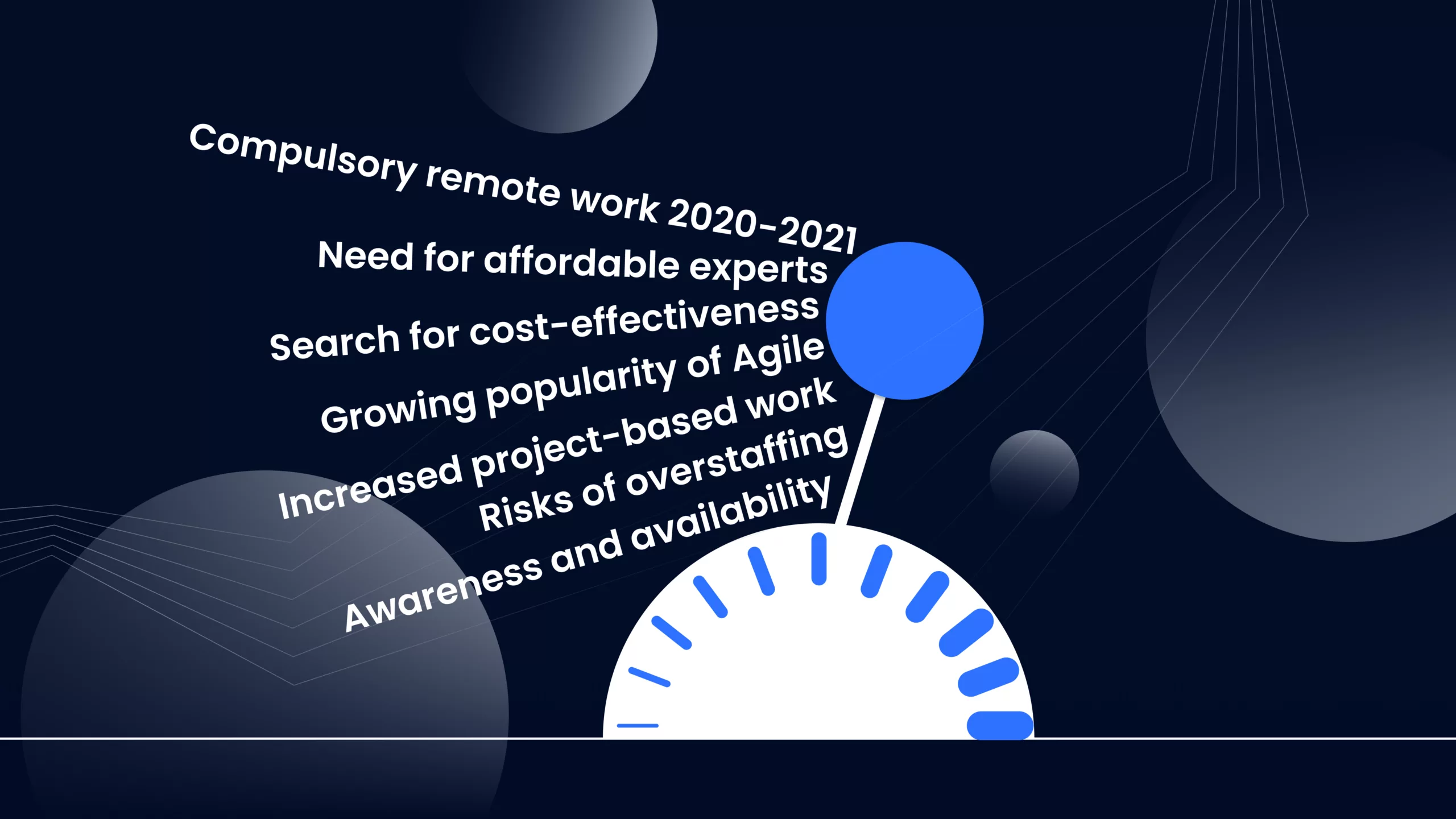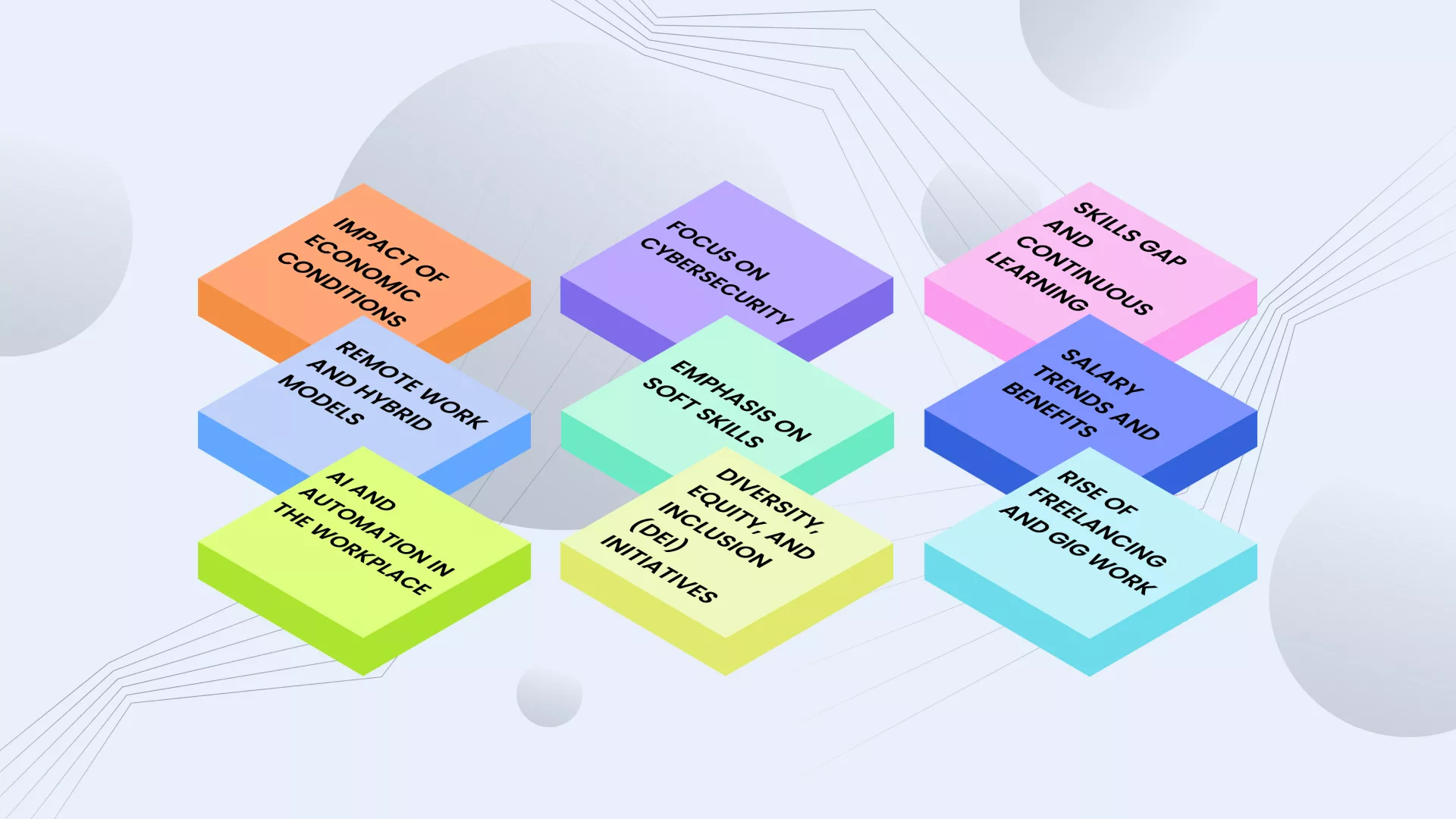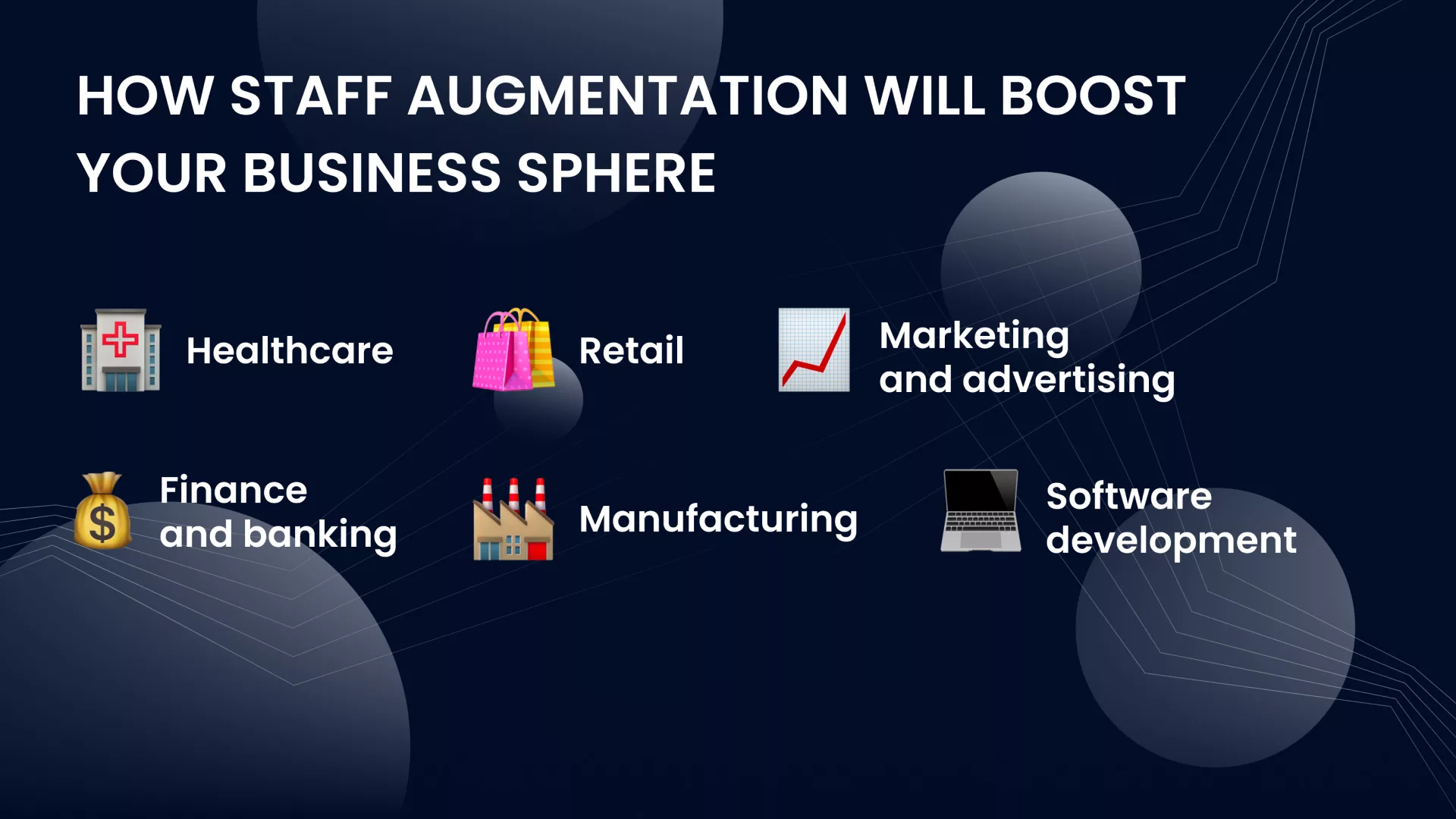
The rise of remote work and cloud computing during the COVID-19 pandemic has dramatically affected workforce trends. Geopolitical instabilities in Europe, West Asia, and South America in 2022-2023 have only added to the software development and labor market instability. One of the results of all the challenges we’ve been through and will be through in 2024 is the rising popularity of the staff augmentation model as one of the IT outsourcing strategies. Let’s see if this trend suits your business needs!
Content:
- Staff augmentation: Meaning
- Analyzing staff augmentation trends
- Why staff augmentation has gained popularity over the years?
- IT labor market trends and shifts in work dynamics
- How does staff augmentation address modern challenges?
- Benefits of staff augmentation for your business
- Tech companies that owe their success to staff augmentation
- Key considerations for implementing staff augmentation
- What staff augmentation trends should we anticipate in 2024?
- Summing up
Staff augmentation: Meaning
At its core, staff augmentation is a flexible outsourcing model that allows companies to hire skilled professionals on a temporary basis to complement and reinforce their existing workforce.
Today’s staff augmentation is characterized by its focus on highly specialized skillsets and flexibility. Unlike traditional outsourcing, where an entire project or function is handed over to another company, staff augmentation brings in external personnel to work under the client’s management and alongside their existing team. As businesses increasingly adopt project-based structures and agile methodologies, the demand for staff augmentation is expected to grow.
Analyzing staff augmentation trends

One of the graphic demonstrations of the rising interest in the staff augmentation model is the increasing number of search requests on Google. Below is the graph of the popularity of the “staff augmentation” phrase according to Google Trends over the last five years – you can see that the interest in this model has almost doubled across the world.
Why has this shift happened? We believe it is due to seven key factors.

- Compulsory remote work 2020-2021. The Covid pandemic was a disaster that has brought us rapid technological advancements. According to Statista, over 90% of businesses in IT and digital spheres have transferred their operations to the cloud, making remote work from any part of the world even simpler. Outsourced staffing became possible and could be easily achieved.
- Need for affordable experts. Staff augmentation allows businesses to hire the best talent from around the world, regardless of geographical boundaries. Companies wanted to gain a competitive advantage with the help of lower direct labor costs. With the evolving cloud computing and remote collaboration tools, this finally becomes widely possible.
- Search for cost-effectiveness. Compared to the costs associated with hiring full-time employees (like benefits, training, and infrastructure), staff augmentation can be more cost-effective, especially for short-term projects.
- Growing popularity of Agile. With the increasing adoption of agile and lean methodologies in project management, companies prefer a more adaptable workforce. Staff augmentation fits well into this paradigm, offering the agility to adapt rapidly to changing project needs.
- Increased project-based work. The modern economy sees more companies undertaking project-based staffing. The outstaffing model provides an efficient way to close open positions on such projects with the right expertise without the need for long-term employment commitments.
- Risks of overstaffing. Do you see how the staff-augmentation-popularity graph above became sharper by the end of 2022? This happened right after the November massive layoffs, when hundreds of thousands of IT and digital experts were fired by large and medium tech companies like Meta and Amazon. From now on, companies have started to be afraid of overstaffing and have decided to opt for safer options, including temporary staffing solutions.
- Awareness and availability. The increasing awareness of staff augmentation as a viable business strategy, along with the growing number of service providers in this space, has massively contributed to its popularity.
Why staff augmentation has gained popularity over the years?
Outsourcing worked perfectly well for decades, so why have businesses switched to other flexible staffing solutions? Because traditional outsourcing isn’t perfect and doesn’t fit all demands. Staff augmentation became the way IT vendors wanted to tackle the most prominent outsourcing drawbacks. With their new services, companies like MWDN asked their clients:
- Do you want greater control and oversight? Staff augmentation gives businesses more control over their projects and workforce. Unlike outsourcing, staff augmentation enables companies to manage external professionals as part of their internal team, maintaining greater control over project direction and outcomes.
- Do you want to be more agile? Economic instability and unforeseen global events have made flexibility a key concern for businesses. Staff augmentation provides the agility to scale the workforce, allowing companies to respond to fluctuating market demands and economic conditions without the financial burden of permanent hires.
- Do you want your processes to keep going no matter what? The pandemic and other crises like wars and sanctions have disrupted traditional business operations. Staff augmentation has offered a way for businesses to maintain continuity and adapt to new challenges.
- Do you want to stay adapted to rapid technological changes? The pace of technological advancement, partly accelerated by global events, has made it difficult for companies to keep up with the required skill sets internally. Staff augmentation offers a solution to bridge this skills gap quickly.
- Do you want people who work on your project to share your values? Augmented staff work alongside the existing workforce, which can lead to better collaboration, knowledge, and value sharing. This integration is especially important for projects where institutional knowledge and understanding of existing systems are crucial.
- You don’t trust outsourcing companies that work without you controlling the workflow and the processes? With growing concerns about data privacy and compliance, especially in industries like finance and healthcare, companies may prefer staff augmentation to ensure that augmented staff adhere to internal and regulatory standards.
IT labor market trends and shifts in work dynamics

Here are nine trends we can all see in the global IT labor market. These trends determine where the staff augmentation model develops, so we should be aware of them.
- Remote work and hybrid models. The pandemic significantly accelerated the shift towards remote and hybrid work models. In 2023, many IT professionals continue to work remotely, at least part of the time, leading to a more geographically dispersed workforce.
- Focus on cybersecurity. With the increase in cyber threats and data breaches, there is a heightened focus on cybersecurity skills. Companies are investing more in securing their digital assets, increasing demand for cybersecurity professionals.
- Rise of freelancing and gig work. The gig economy continues to grow, with more IT professionals opting for freelance and contract work for greater flexibility and autonomy. This shift is supported by platforms facilitating gig work in the IT sector.
- Skills gap and continuous learning. As technology evolves rapidly, a skills gap remains a challenge. There’s a trend towards continuous learning and upskilling, with both individuals and companies investing in education and training to keep pace with technological advancements.
- Emphasis on soft skills. Alongside technical abilities, there’s an increasing emphasis on soft skills. The collaborative nature of modern IT work and the prevalence of remote teams make communication, problem-solving, and adaptability more critical.
- Diversity, equity, and inclusion (DEI) initiatives. There’s a growing focus on DEI in the IT sector. Companies are actively working to create more inclusive work environments and diversify their tech workforce.
- Salary trends and benefits. With the high demand for IT professionals, salaries in the sector remain competitive. Companies are also offering comprehensive benefits packages, including wellness programs and flexible work arrangements, to attract and retain talent.
- AI and automation in the workplace. Integrating AI and automation into business processes impacts job roles and functions. While it creates efficiency, it also requires workers to adapt and learn how to work alongside these technologies.
- Impact of economic conditions. Global economic conditions, including inflation and market uncertainties, influence hiring trends and IT department budget allocations.
How does staff augmentation address modern challenges?
Adaptation to technological change → As technology evolves, the skills needed today might be different tomorrow. Staff augmentation enables businesses to keep an agile workforce and adapt quickly by bringing in professionals with the latest skills and knowledge.
Reduced hiring and training time → The process of recruiting and training new full-time employees can be lengthy. Staff augmentation offers a quicker solution, as the staff provided by augmentation services is already vetted and has the required skills.
Compliance and administrative ease → Staff augmentation firms often handle the administrative and compliance aspects of employment, reducing the burden on the company’s HR and legal departments.
Innovation → By bringing in fresh perspectives and specialized knowledge, augmented staff can contribute to innovation and help companies gain a competitive edge in their market.
Meeting DEI goals → Companies striving for DEI in their workforce can use staff augmentation to bring in diverse talent from different backgrounds and geographies.
Benefits of staff augmentation for your business

Contract staffing models are beneficial for almost every tech or digital niche there is. Check out how staff augmentation will boost your business sphere.
Healthcare
Imagine a hospital needing to implement a new EHR system. Staff augmentation can provide IT professionals with experience in healthcare technology, ensuring a smooth transition to the new system without overburdening permanent staff.
Finance and banking
Imagine a bank looking to develop a new fintech application. By choosing skills augmentation, it gets access to fintech experts and software developers who can work on the project with existing staff, bringing in fresh ideas and expertise without a long-term hiring commitment.
Manufacturing
Imagine a manufacturing firm that needs to upgrade its automation and robotics. Staff augmentation will bring in engineers and specialists in automation for the duration of the upgrade project, providing specialized skills that might not be available in-house.
Retail
Imagine an e-commerce retailer experiencing a seasonal surge during holidays. On-demand workforce can handle increased customer service, IT support, or logistics demands, aligning workforce numbers with seasonal fluctuations.
Marketing and advertising
Imagine an advertising agency with an extensive, time-sensitive campaign. Staff augmentation can provide graphic designers, copywriters, or digital marketing experts to bolster the agency’s capacity and creativity for the campaign duration.
Software development
Imagine a software development company facing a sudden increase in project workload. By choosing flexible staffing solutions, it can access specialized skills (e.g., AI, cybersecurity, or app development) on a project basis. Along with that, the company receives agility in scaling the team and reduces the time and cost associated with hiring full-time specialists.
If your business or project is from another domain we haven’t mentioned here, don’t let this stop you! Contact us so we can see how we can help you progress.
Tech companies that owe their success to staff augmentation

Most companies (almost 80% if we judge by MWDN) don’t want the public to know that they go for IT outsourcing or staff augmentation. Fortunately, over the years, we have seen some information leaks that kind of hint to us how many well-known companies do choose to delegate IT services to third parties.
Alibaba
- What was outsourced: Website development.
- Why: To make the site appealing internationally.
- Alibaba, a giant in e-commerce, started in 1999. Its founder, Jack Ma, hired developers from the US to build a website that worked well both in China and for English-speaking users. This move helped make Alibaba a global success, earning billions in revenue.
Slack
- What was outsourced: App and website design.
- Why: To improve user experience.
- When Slack began in 2013, it was quite basic. Outsourcing its design helped it stand out and attract millions of users. The revamped design was a key reason for its success and large investments.
GitHub
- What was outsourced: Website backend development.
- Why: To get the best Git experts.
- GitHub, popular among developers, outsourced its backend development to get the best Git expertise. Scott Chacon, a Git specialist, was hired, making GitHub a top choice for developers. Microsoft bought GitHub for billions in 2018.
Key considerations for implementing staff augmentation
Here is a quick checklist to look through when you are first hiring a staff augmentation IT vendor.
- Understand the skill gaps or project requirements that your existing team cannot fulfill.
- Define what you aim to achieve through staff augmentation.
- Allocate a budget for staff augmentation.
- Ensure alignment. The augmented staff should directly contribute to the broader objectives of the organization.
- Consider how these temporary roles fit into the long-term strategic workforce planning. Even temporary staff can contribute to long-term goals through knowledge transfer or system improvements.
- Work with reputable staffing agencies with a track record of providing high-quality professionals in your industry.
- Ensure a smooth onboarding process.
- Establish open and effective communication channels.
What staff augmentation trends should we anticipate in 2024?
We don’t know what tomorrow is going to be, but we can predict some trends in staff augmentation based on the logic of the model development during the last few years.
Enhanced focus on remote collaboration tools. As remote work becomes more prevalent, there will be an increased focus on developing and using tools that facilitate effective remote collaboration.
Diversification of talent sources. Companies will likely diversify their talent sources to mitigate risks associated with geopolitical tensions and to access a broader range of skills.
Greater integration of AI in recruitment. AI and machine learning tools will play a more significant role in the recruitment process for staff augmentation, helping to match specific skill sets with project requirements.
Summing up
We believe that staff augmentation is the collaboration model of the future. It has all the pros of having an in-house team and outsourcing IT services to third parties. At the same time, it doesn’t have in-house hiring and outsourcing downsides, like high costs or a lack of control.
This is our second text about trends, forecasts, and predictions for staff augmentation and software development in 2024. Check out other MWDN articles on this topic.
Content
- 1 Staff augmentation: Meaning
- 2 Analyzing staff augmentation trends
- 3 Why staff augmentation has gained popularity over the years?
- 4 IT labor market trends and shifts in work dynamics
- 5 How does staff augmentation address modern challenges?
- 6 Benefits of staff augmentation for your business
- 7 Tech companies that owe their success to staff augmentation
- 8 Key considerations for implementing staff augmentation
- 9 What staff augmentation trends should we anticipate in 2024?


